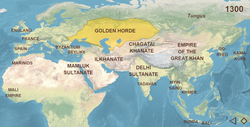
Back Kawan Meuih ACE Goue Horde Afrikaans Goldene Horde ALS Horda d'Oro AN خانية القبيلة الذهبية Arabic القبيله الدهبيه ARZ Horda d'Oru AST Qızıl Orda Azerbaijani آلتین اوردو AZB Алтын Урҙа Bashkir
Great State اولوغ اولوس Ulug Ulus | |
|---|---|
| 1225–1502[1] | |
|
Flag during the reign of Öz Beg Khan as shown in Dulcert's 1339 map (other sources claim that the Golden Horde was named for the yellow banner of the khan)[2] | |
 Territories of Golden Horde as of 1300 | |
| Status | Nomadic empire |
| Capital | |
| Common languages | |
| Religion |
|
| Government | Semi-elective monarchy, later hereditary monarchy |
| Khan | |
• 1225 | Jochi (first) |
• 1226–1280 | Orda Khan (White Horde) |
• 1242–1255 | Batu Khan (Blue Horde) |
• 1379–1395 | Tokhtamysh |
• 1459–1465 | Mahmud bin Küchük (Great Horde) |
• 1481–1502 (last) | Sheikh Ahmed |
| Legislature | Kurultai |
| Historical era | Late Middle Ages |
• Established | 1225 |
• Blue Horde and White Horde united | 1379 |
• Disintegrated into Great Horde | 1466 |
| 1480 | |
• Sack of Sarai by the Crimean Khanate | 1502[1] |
| Area | |
| 1310[5][6] | 6,000,000 km2 (2,300,000 sq mi) |
| Currency | Pul, som, dirham[7] |
| |
The Golden Horde, self-designated as Ulug Ulus (lit. 'Great State' in Kipchak Turkic),[8] was originally a Mongol and later Turkicized khanate established in the 13th century and originating as the northwestern sector of the Mongol Empire.[9] With the division of the Mongol Empire after 1259, it became a functionally separate khanate. It is also known as the Kipchak Khanate or the Ulus of Jochi,[a] and replaced the earlier, less organized Cuman–Kipchak confederation.[10]
After the death of Batu Khan (the founder of the Blue Horde) in 1255, his dynasty flourished for a full century, until 1359, though the intrigues of Nogai instigated a partial civil war in the late 1290s. The Horde's military power peaked during the reign of Özbeg Khan (1312–1341), who adopted Islam. The territory of the Golden Horde at its peak extended from Siberia and Central Asia to parts of Eastern Europe from the Urals to the Danube in the west, and from the Black Sea to the Caspian Sea in the south, while bordering the Caucasus Mountains and the territories of the Mongol dynasty known as the Ilkhanate.[10]
The khanate experienced violent internal political disorder known as the Great Troubles (1359–1381), before it briefly reunited under Tokhtamysh (1381–1395). However, soon after the 1396 invasion of Timur, the founder of the Timurid Empire, the Golden Horde broke into smaller Tatar khanates which declined steadily in power. At the start of the 15th century, the Horde began to fall apart. By 1466, it was being referred to simply as the "Great Horde". Within its territories there emerged numerous predominantly Turkic khanates. These internal struggles allowed Moscow to formally rid itself of the "Tatar yoke" at the Great Stand on the Ugra River in 1480, which traditionally marks the end of Mongol rule over Russia.[11] The Crimean Khanate and the Kazakh Khanate, the last remnants of the Golden Horde, survived until 1783 and 1847 respectively, when they were conquered by the expanding Russian state.
- ^ Halperin 1987, p. 78.
- ^ Zahler, Diane (2013). The Black Death (Revised ed.). Twenty-First Century Books. p. 70. ISBN 978-1-4677-0375-8.
- ^ a b c Kołodziejczyk (2011), p. 4.
- ^ Mustafayeva, A. A.; Aubakirova, K. K. (June 2021). "The language situation and status of the Turkic language in the Egyptian Mamluk state and Golden Horde". Journal of Oriental Studies. 97 (2): 17–25. doi:10.26577/JOS.2021.v97.i2.02. ISSN 2617-1864. Retrieved 1 September 2021.
- ^ Turchin, Peter; Adams, Jonathan M.; Hall, Thomas D (December 2006). "East-West Orientation of Historical Empires". Journal of World-Systems Research. 12 (2): 222. ISSN 1076-156X. Retrieved 12 September 2016.
- ^ Rein Taagepera (September 1997). "Expansion and Contraction Patterns of Large Polities: Context for Russia". International Studies Quarterly. 41 (3): 498. doi:10.1111/0020-8833.00053. JSTOR 2600793.
- ^ Fedorov-Davydov, German A. "The Monetary System of The Golden Horde". Translated by L. I. Smirnova (Holden). Retrieved 14 July 2017.
- ^ "The History and Culture of the Golden Horde (Room 6)". Saint Petersburg: The State Hermitage Museum. Retrieved 21 March 2020.
- ^ Perrie, Maureen, ed. (2006). The Cambridge History of Russia. Vol. 1: From Early Rus' to 1689. Cambridge University Press. p. 130. ISBN 978-0-521-81227-6.
- ^ a b "Golden Horde". Encyclopædia Britannica. 2007.
Also called Kipchak Khanate Russian designation for Juchi's Ulus, the western part of the Mongol Empire, which flourished from the mid-13th century to the end of the 14th century. The people of the Golden Horde were mainly a mixture of Turkic and Uralic peoples and Sarmatians & Scythians and, to a lesser extent, Mongols, with the latter generally constituting the aristocracy. Distinguish the Kipchak Khanate from the earlier Cuman-Kipchak confederation in the same region that had previously held sway, before its conquest by the Mongols.
- ^ Cite error: The named reference
Millarwas invoked but never defined (see the help page).
Cite error: There are <ref group=lower-alpha> tags or {{efn}} templates on this page, but the references will not show without a {{reflist|group=lower-alpha}} template or {{notelist}} template (see the help page).
